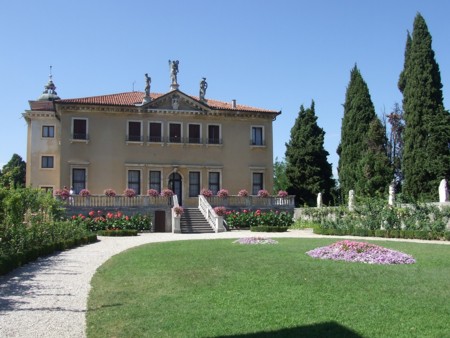A Vicenza excursion
Even if you’re only in Vicenza for a day trip, I strongly recommend you spend two or three hours visiting these sights just outside town. La Rotonda is an important Palladian villa, Villa Valmarina ai Nani a charming and less formal house, and the views from Monte Berico on a clear day are absolutely fantastic. If you visit Vicenza without seeing these sights, you’re really missing something special. The three can be combined in an excursion which is manageable on foot from the city centre, although I’d recommend starting by bus. Note the opening times first; the best day for this outing is a Wednesday when La Rotonda is open to the public. On other days (restricted times) you can pay to enter the grounds.
Part of the walk (between the villas) is on a roughly-surfaced footpath, and there will be some uphill whichever way you walk. However we made this outing on a hot summer day and didn’t find the gradients too tiring. There’s plenty of shade.
We began by taking a bus out of town to La Rotonda. This bus is infrequent; if you take it on your return you will have to wait on a main road without shelter, maybe for some time. So we advise taking the bus out, and walking back. Directions for the walk are in italics.
The bus for La Rotonda is the number 8. It has two stops on Viale Roma, the avenue linking the railway station with the town centre. Then it loops around and passes the station, stopping outside. From here it is a short ride – under ten minutes – to the stop for La Rotonda. Ask the driver to tell you where to get off. The timetable is displayed on the bus stop; buy bus tickets beforehand in a bar or news-kiosk.
From the bus stop take the first road uphill on your right – it is signposted for the villa. After a short walk up the hill you pass a footpath on your right indicated for the Villa Valmarana ai Nani. Later you’ll take this route, but first continue a few yards to La Rotonda, on your left.
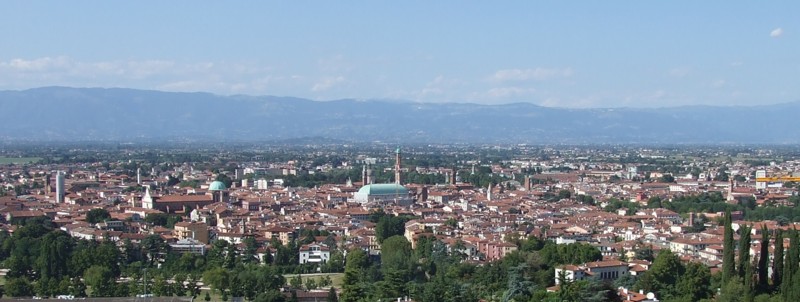
La Rotonda
This building, also called by various permutations of the name Villa Almerico Capra Valmarana (after its past owners) is usually known simply as La Rotonda for its domed form. Designed by Andrea Palladio in the 1560s (although it wasn’t finished for several decades), the building is a perfect expression of Palladio’s love of symmetry and classical forms. The villa is a cube, with a temple-style façade on each side, topped by a central dome.
The interior was designed for elegant entertainment, and is lavishly decorated with stucco and frescoes. Visitors can view the grand main floor, the piano nobile, and gaze up at the decorated dome, inspired by the Pantheon in Rome.
The villa doesn’t have large gardens, but there is a lawn with some good viewpoints for admiring the building. You can walk all around the exterior admiring the finer details of its architecture.
Opening hours may be very limited – check the latest times and ticket prices online before you make your plans to visit.
The villa is very commercialised as an attraction. Apart from the expensive entrance charge, you’ll find all kinds of branded souvenir items and also a threatening notice asserting all rights to any images of the building or architecture. If the villa is closed or you don’t want to spend money you could simply peer through the gate. There are also good, though more distant, views of the villa from the main road below (the route the bus takes).
After visiting the villa, retrace your steps to the start of the footpath to Villa Valmarana. This walled dirt path heads uphill and bends around to emerge right outside the villa, after only about five minutes.
Villa Valmarana ai Nani
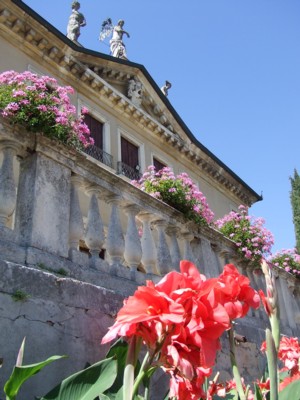
This villa belonging to the Valmarana family takes its name from the statues of dwarves (nani) which decorate its garden wall. There are various explanations for these: that they record the legend of a suicidal “dwarf princess” who used to live on the site, or perhaps that the statues were sculpted to please a young child of the family.
The main villa’s piano nobile is open to the public. Like most of the countryside villas in the Veneto, it contains a fairly modest amount of space and was designed for summer entertaining. The central hall and corner rooms are covered in frescoes by Giambattista Tiepolo depicting mythological and literary scenes. The foresteria, a separate building which was used to house guests, is frescoed by Tiepolo’s son, this time with rural landscapes and activities.
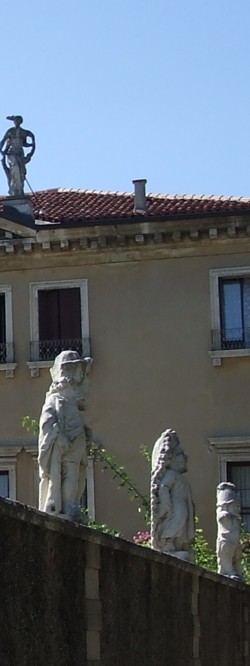
The villa has some pretty gardens with lovely views over green countryside which is reminiscent of Tuscany. Although the house is elegant and lavishly decorated, it has a much more charming and homely feel than the temple-like Rotonda.
As well as a small array of goods and guidebooks for sale, the villa also has free guides in different languages which can be borrowed. These take you through room by room, explaining the themes of the frescoes. The villa is open between March and November. From Tuesday to Sunday it opens 10am – 12 noon, and on Wednesday, Thursday, Saturday and Sunday it’s also open in the afternoon from 3pm -6pm (check the latest times before visiting). There’s an admission fee.
When you leave the villa, follow the road which leads under the wall lined with stone dwarves. Continue uphill in the same direction along the walled, cobbled Via San Bastian. This emerges onto a leafy hillside street with benches, Via Massimo d’Azeglio. At the end is Viale 10 Giugno, which climbs up to the Basilica di Monte Berico.
Monte Berico
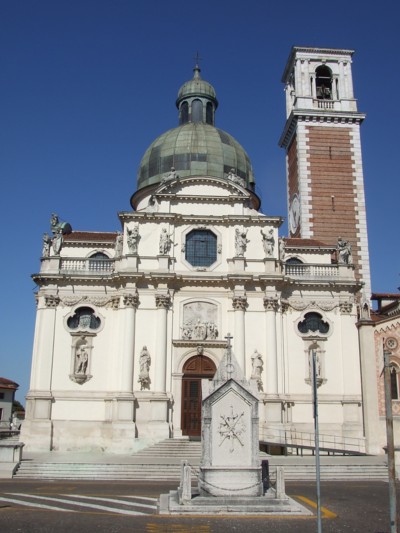
Monte Berico is a hill on the southern side of Vicenza. Centuries ago there were two apparitions of the Virgin Mary here, and a church was built on the site. The grand Basilica di Monte Berico, with its three Baroque facades and a painting by Veronese, is worth visiting, but the views from the hillside are just as impressive.
From a large panoramic car park there are staggering views over Vicenza and to the mountains beyond, the edge of the Dolomites. On a clear day this is a fantastic place to come, both for enjoying the views and for getting a sense of the landscape of this part of the Veneto. There are cafes where you can purchase refreshments.
Across the road from the church, just above the car park, is a sign to a ‘Monumento alla Mama’ a sweet statue of a mother and baby.
From Monte Berico you can simply descend the long arcaded walk to the foot of the hill. The railway station is a few minutes’ walk away to the left.
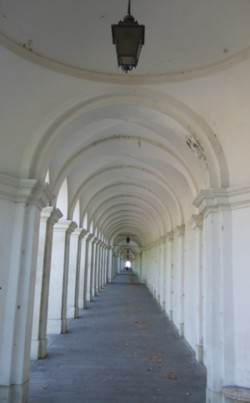
About the excursion
This entire excursion, from catching the bus in Vicenza to arriving back at the railway station, took approximately two and a half hours, including visits to both the villas. We found it a great way to spend the afternoon after sightseeing and lunch in the town centre.
> Vicenza travel and tourist information
> Book a hotel or B&B in Vicenza
If you are driving
There are very limited amounts of parking outside the two villas, which are along narrow country roads. At Monte Berico there is a large car park.
On this site
Veneto art & architecture itinerary
Useful external links
Veneto destinations
- Veneto region
- Abano Terme
- Asolo
- Bassano del Grappa
- Brenta Canal
- Caorle
- Castelfranco Veneto
- Chioggia
- Cittadella
- Concordia Sagittaria
- Conegliano
- Cortina d’Ampezzo
- Lido di Jesolo
- Malcesine
- Marostica
- Monselice
- Montegrotto Terme
- Padua
- Portogruaro
- Rovigo
- Sottomarina
- Treviso
- Venetian Lagoon
- Venice
- Verona
- Vicenza
- Veneto art & architecture itinerary
- Veneto villas – Vicenza: La Rotonda & Villa Valmarana ai Nani
- Veneto villas – Villa Pisani & Villa Foscarini Rossi, Strà
- Venice Airport
- Treviso Airport
